Level Up Your Knife Skills for Cooking: Slice, Dice, and Chop Like You Mean It

Knife skills for cooking are the foundation of becoming a confident, efficient home chef. Here at Chow Time Fellers, we’re not just another food blog throwing fancy terms at you – we’re those people who actually want you to succeed in the kitchen. And let us tell you, nothing changed our cooking game like learning proper knife skills. We went from dreading prep work to actually enjoying it (well, most days).
So you want to get better at using knives in the kitchen? Having solid knife skills doesn’t just make you look cool (though it definitely does) – it’s one of those game-changing abilities that separates the “I can follow a recipe” folks from the “I actually know what I’m doing” home cooks.
What You’ll Learn Here (Key Takeaways)
The three knives you actually need (chef’s knife, paring knife, and serrated knife) and how they’ll make your prep work way less crazy
How to keep your knives sharp and ready (because dull knives are dangerous knives)
Basic and fancy knife skills that’ll have you prepping food faster and more evenly
The Only Kitchen Knives You Really Need
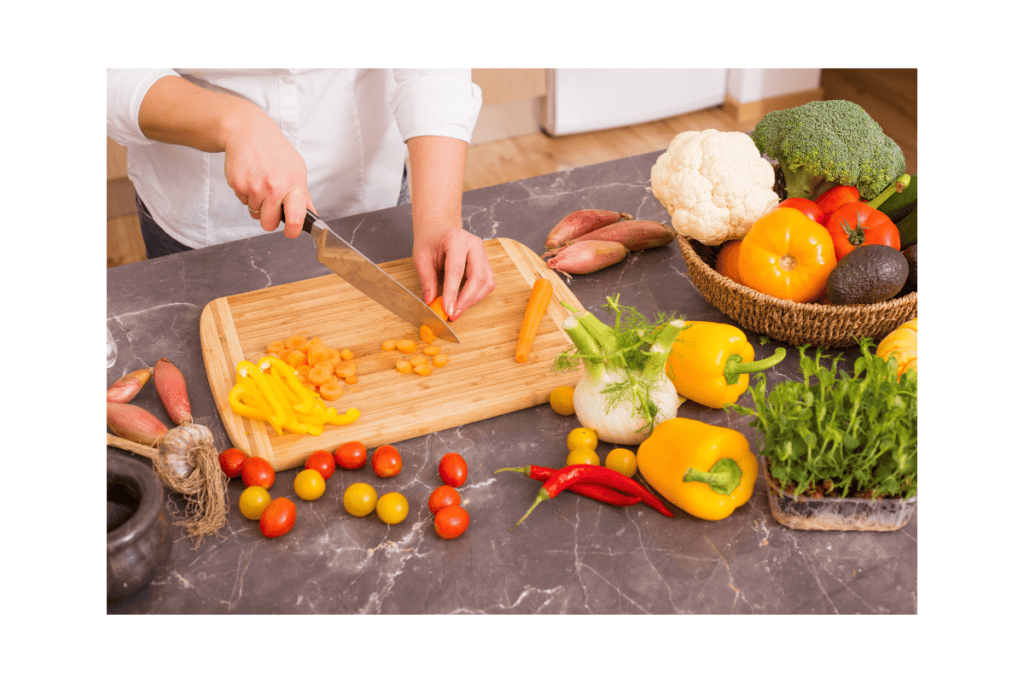
Let’s talk about the three foundational knives that every kitchen needs. While those fancy knife block sets aren’t just for show (we use every single knife in our Chow Time kitchen for different specialized tasks), these three workhorses form the foundation that you’ll use most often. If you’re just starting out or building your collection, here’s where to begin:
The Chef’s Knife: Your Kitchen MVP

Think of your chef’s knife as the quarterback of your kitchen team. This wide-bladed beauty handles everything from slicing foods to dicing potatoes to chopping vegetables.
When you’re shopping for a chef’s knife, pick one that feels good in your hand with a blade that’s thick at the heel and tapers down to the tip. If you’re just getting started, an 8-inch chef’s knife gives you plenty of cutting power without being unwieldy. The Victorinox Fibrox Chef’s Knife is a solid option that won’t break the bank.
Most professional chefs start their training with a chef’s knife because it’s so versatile. Once you get comfortable with it, you can do everything from finely mincing garlic to breaking down a whole chicken. Getting good with this one tool can make you prep food as efficiently as the pros.
The Paring Knife: Your Detail Specialist

A paring knife is like that person on your team who’s really good at one specific thing. It’s built for precision work like peeling fruits or shaping vegetables. The small size and sharp edge give you total control when you need a gentle touch.
Don’t let its size fool you – this little knife punches way above its weight class.
The Serrated Knife: Your Texture Master

When you need to cut something with a tough exterior but soft inside (like bread or tomatoes), a serrated knife is your best friend. Look for one with a wavy blade and a comfortable handle.
The serrated design grabs and cuts through these foods without squishing them – something straight-edged knives just can’t handle.
Home cooks, take note: both paring and serrated knives are pretty affordable, so there’s no excuse not to add them to your arsenal.
Taking Care of Your Knives
Keeping your knives sharp makes cooking faster, safer, and more precise. Sharp knives cut food consistently so it cooks evenly. Dull knives force you to push harder, which is how slips and cuts happen. Get in the habit of honing your knife regularly and sharpening it every few weeks.
Cleaning your knives matters too. Wash them with warm soapy water and a sponge after each use, then let them air-dry to prevent rust and damage. Store them in a rack, block, magnetic strip, or sheath to protect the blades and keep accidents from happening. Pick a storage method that works for your kitchen space and what feels right to you.
Using a Honing Steel

Here’s something many home cooks get wrong: that long metal rod that came with your knife set isn’t actually for sharpening. It’s called a honing steel – basically a ridged metal stick that helps straighten the edge of your knife blade when it gets bent out of shape from regular cutting.
See, when you use your knife, the super-thin edge can bend slightly (too small to see with your eye, but enough to make cutting less effective). The honing steel realigns that edge without removing any metal. Think of it like straightening a bent paperclip – you’re not creating a new edge, just fixing the one you have.
Use your honing steel weekly, or ideally each time you use your knives. Run the knife blade down the steel at a 20-degree angle, using a smooth, sweeping motion several times on each side. It doesn’t actually sharpen the knife, but keeps the edge aligned so your knife keeps performing at its best. This single habit separates professional chefs from home cooks and makes kitchen work so much easier.
Quick note: Don’t use a honing steel on your serrated knife. Those saw-like teeth on the serrated knife blade have a different structure and can actually be damaged by a standard honing steel. Serrated knives generally stay sharper longer and require special sharpening tools when they eventually dull.
Getting Your Knives Actually Sharp
For home sharpening, manual sharpeners are user-friendly and get the job done. Professional chefs often prefer wet stones because they can create a super sharp edge.
Unlike honing, sharpening actually removes metal from the blade to create a fresh edge. When honing doesn’t bring back the sharpness, it’s time to use a hand-held sharpener.
To sharpen without damaging your knife, draw it lightly through a hand-held sharpener, checking frequently for sharpness. Don’t push too hard – you’ll damage the edge and make the knife cut worse, not better.
Frequent, light sharpening takes less time and removes less material than waiting until your knife is totally dull. Consistency is your friend here.
Storing Knives Without Ruining Them
Store your knives safely to protect the blades and prevent accidents. Racks, blocks, magnetic strips, and sheaths all work – they keep blades protected, easy to access, and out of the way.
When choosing storage, think about your kitchen size, what types of knives you have, and what works for your cooking style. Good storage keeps both you and your knives safer.

Getting the Basics: Knife Skills for Cooking
Solid knife skills make meal prep faster and cooking more enjoyable. These basic skills improve both the texture and flavor of your everyday cooking. Knowing how to properly hold a knife and position your ingredients makes a massive difference.
The fundamental knife skills – slicing, dicing, and chopping – aren’t just chef-school fancy stuff. They help food cook evenly, save you time, and keep your fingers attached to your hands (which is important). Learning the proper grip, the claw technique, and how to stabilize ingredients might seem fussy at first, but they’ll quickly become second nature.
How to Hold a Knife Without Looking Like a Horror Movie Villain
The right way to hold a knife gives you control, prevents slipping, and protects your fingers. For a chef’s knife, put your thumb on one side and index finger on the other, pinching near where the blade meets the handle. Wrap your other fingers around the handle for stability.
Professional chefs love what’s called the pinch grip because it gives them better control when chopping or mincing. Position your elbow level with your cutting surface to apply downward pressure efficiently.

The Claw Technique: Keep All Your Fingers
The claw technique is how you’ll make it through decades of cooking with all ten fingers intact. Position your non-knife hand with fingers curled back into a claw shape to hold the ingredient steady while keeping your fingertips safely away from the blade.
This grip protects your fingers and gives you better control, improving both precision and safety.
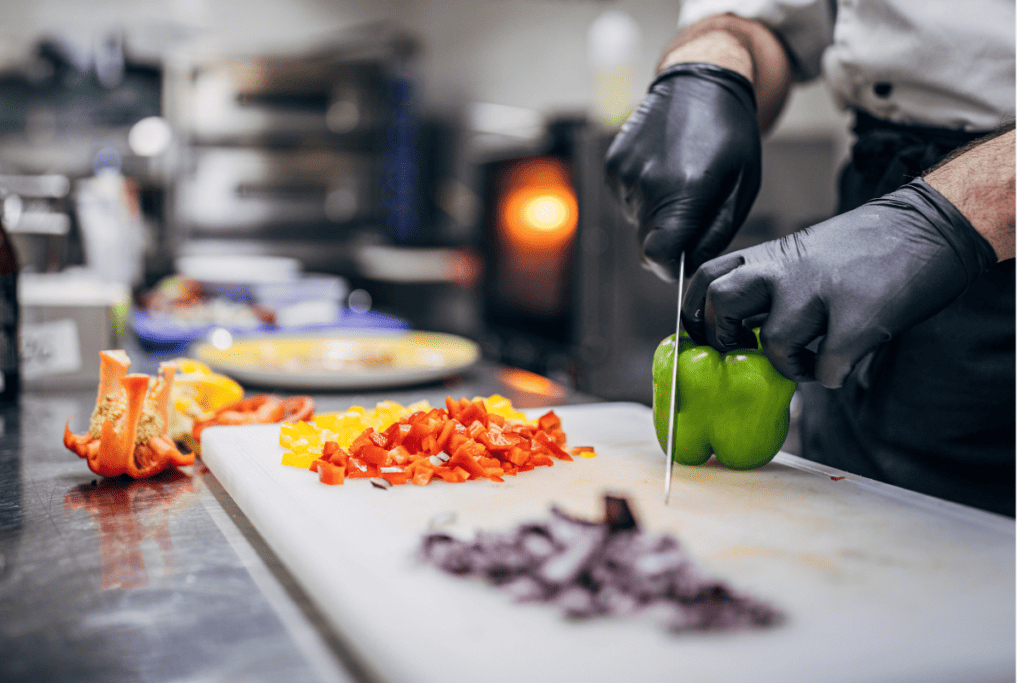
Stabilizing What You’re Cutting
For safe and effective knife skills, you need a stable cutting surface. Create flat surfaces on rounded vegetables by slicing off a small portion. This gives you a stable base on the cutting board for more controlled, accurate cuts.
This simple step dramatically improves both the safety and efficiency of your cutting.
The Knife Cuts You Need to Know
Cutting meat and vegetables uniformly doesn’t just make your food look better – it makes it taste better too. Consistent knife cuts like dicing, slicing, chopping, julienne, and mincing allow food to cook evenly. This prevents some pieces from burning while others are still raw.
These knife cuts matter for everyone from beginning home cooks to professional chefs. They ensure even cooking and make your food look like you know what you’re doing. Practicing these techniques will seriously level up your cooking game.
Slicing: The Foundation
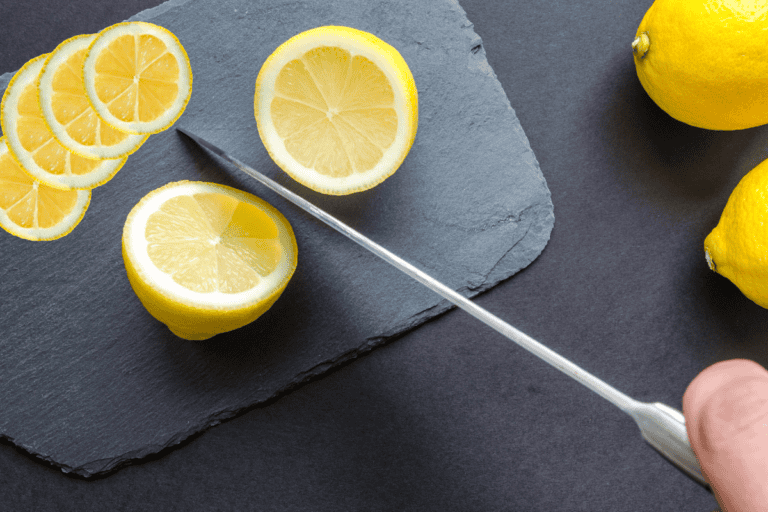
Using a rocking motion while slicing creates uniform, thin cuts that make your prep work more efficient and precise.
This technique is perfect for vegetables, meats, and breads that need to cook evenly and look good on the plate.
Dicing: When Size and Shape Matter
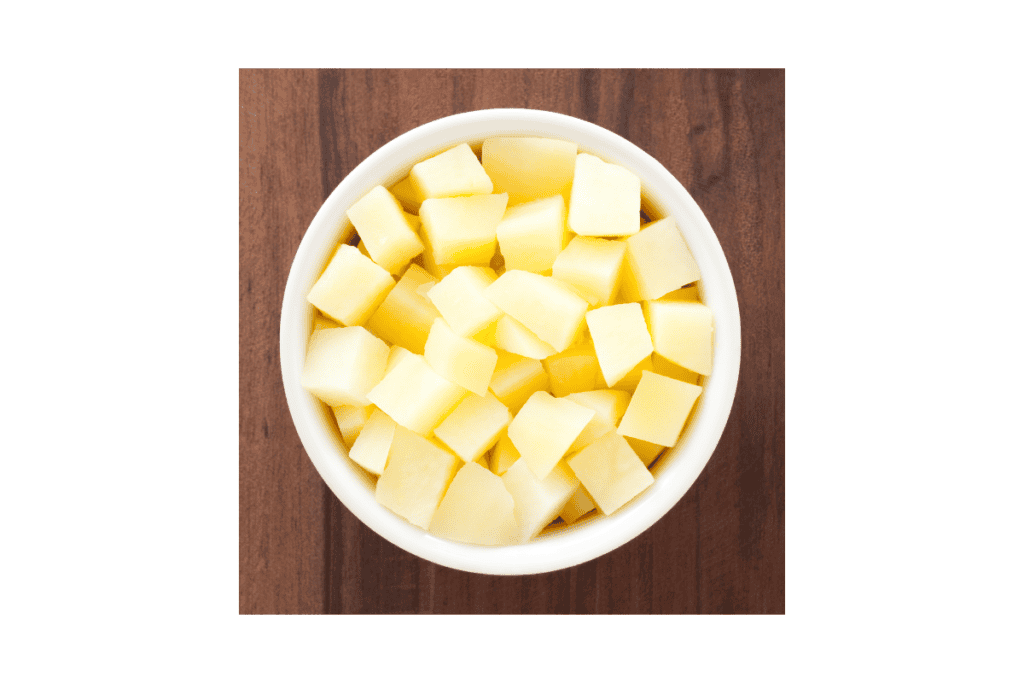
Dicing turns irregular fruits and vegetables into uniform cubes that cook evenly. Different dice sizes serve different purposes: small dice for salsa, medium dice for soups and casseroles, and large dice for roasted dishes.
To dice a potato, cut it into equal rectangles, then into strips, and finally into cubes. For a different approach, halve it, peel it, and make horizontal and vertical slices while it’s lying flat. To dice a tomato, quarter it, gently flatten, cut into strips, then into uniform cubes.
Using the claw grip ensures safety and consistency in your diced ingredients.
Chopping: Fast and Casual
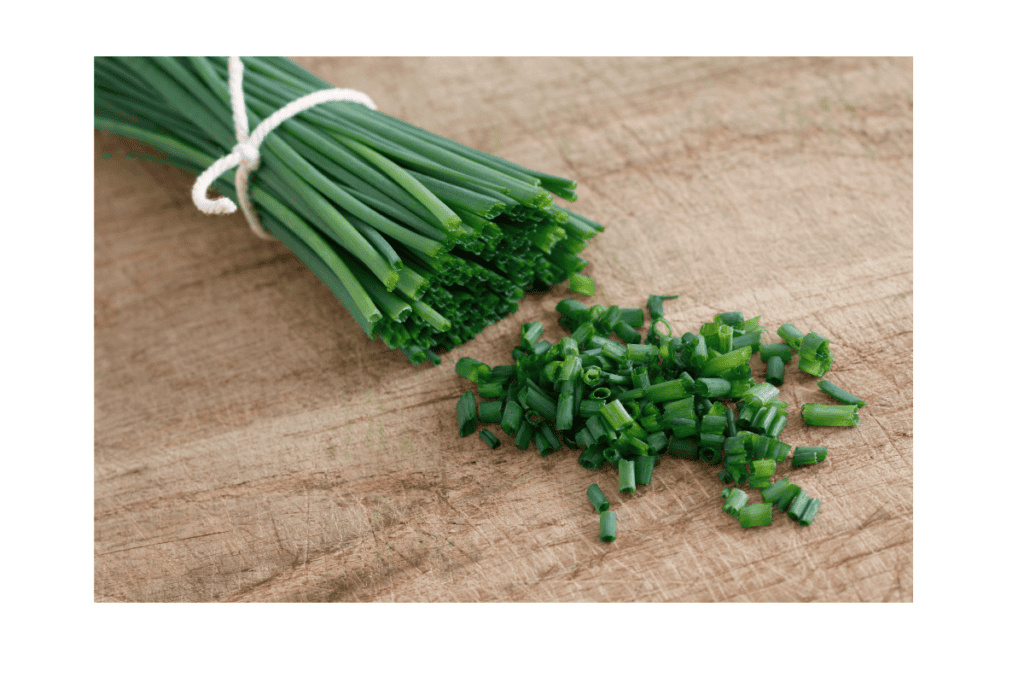
Chopping is making quick, less precise cuts that give you irregularly shaped pieces. This technique works great when exact sizing isn’t the priority, like for vegetables going into soups or stocks.
It’s a fundamental and flexible technique that every home cook needs to master since it’s the foundation of so many recipes.
Julienne and Batonnet: The Fancy Sticks

Julienne cuts turn vegetables into thin strips that cook quickly and evenly. To julienne celery, trim the tough ends and leaves, cut into 2-inch pieces, and slice using a rocking motion.
These cuts are perfect for stir fries, salads, garnishes, and raw vegetable platters.
Mince: The Tiny Bits

Mincing breaks food down into super small pieces. This fine chopping method quickly reduces ingredients to release maximum flavor. Garlic, ginger, and various root vegetables are usually minced.
To get a fine mince of parsley, you’ll want to chop it thoroughly three to four times.
Advanced Cutting Techniques for Showing Off
Once you’ve mastered the basics, you can level up with advanced cutting techniques that make your food look and taste better. These methods are part of cooking school curricula and help professional chefs create meals that are as beautiful as they are delicious.
Techniques like chiffonade, oblique cut, and tournée cut might seem intimidating at first, but they become second nature with practice. Each one brings something special to your cooking game.
Chiffonade: Ribbon Cuts for Herbs and Greens

Chiffonade is a method for slicing leafy vegetables into delicate, thin strips that look fantastic on a plate. To chiffonade, stack the leaves, roll them up lengthwise, and slice thinly using a rocking motion.
For example, to chiffonade basil, stack and roll the leaves tightly before slicing. This technique is perfect for garnishing dishes or adding a professional touch to salads and stir fries.
Oblique Cut: The Angle Matters

For the oblique cut (also known as cutting on the bias), which works great on long vegetables like carrots and zucchini, hold the knife at an angle to make slanted slices while rotating the vegetable after each cut. This approach increases surface area for better flavor absorption and ensures more even cooking.
This cutting style makes your food look more sophisticated while improving its flavor and texture.
Tournée Cut: The Pro Move

The tournée cut creates oblong, football-shaped pieces that immediately signal “fancy restaurant food.” This roll cut is often used in gourmet cooking, not just for appearance but as a sign of advanced knife skills.
Executing this cut involves carefully shaping food into elongated forms with consistent size and symmetry.
Putting Your Knife Skills to Work
When you apply your knife skills to actual cooking, that’s when you see the real benefits. Precise cuts make your food look better, cook more evenly, and taste more flavorful. Let’s look at how these cutting skills improve everyday cooking, making meal prep faster and more enjoyable.
Mastering knife techniques transforms your cooking across different dishes, from stir fries to soups, stews, salads, and garnishes. When you cut consistently, you elevate both the flavor profile and appearance of everything you make.
Stir Fries: Quick Cooking Needs Even Cuts
When making stir fries, cutting meat and vegetables uniformly is the difference between a restaurant-quality dish and a disappointing mess. Slicing meat across the grain keeps it tender, while cutting vegetables to the same size ensures they cook evenly. Improving your slicing and dicing techniques makes prep faster and your results better.
Good knife skills guarantee that everything in your stir fry cooks at the same rate, improving both flavor and texture. Whether you’re making a quick weeknight dinner or an elaborate weekend stir fry, these skills help you achieve professional-level results.
Soups and Stews: Consistency Is Key
For soups and stews, uniform cuts ensure ingredients cook evenly. Vegetables like potatoes, sweet potatoes, zucchini, celery, onions, garlic, and carrots are perfect for practicing your knife skills.
To make sure your vegetables blend seamlessly in flavor and texture, practice different cutting techniques like mincing, slicing, and dicing to maintain consistency.
Salads and Garnishes: The Finishing Touch
Techniques like chiffonade elevate the appearance of salads and garnishes, adding professional flair. This approach not only looks good but enhances flavor by allowing dressings and seasonings to coat more surface area.
Using julienne cuts creates even, thin strips that improve both the texture and visual appeal of your salads.
Bringing It All Together
Getting good with a knife can completely change how you cook – making you faster, safer, and happier in the kitchen. Knowing your way around kitchen knives and mastering cutting techniques from basic to advanced is a game-changer for any home cook. Even cuts don’t just make your food look Instagram-worthy – they make it cook evenly and taste better.
By incorporating these cutting techniques into your everyday cooking, you’ll take your culinary skills to a whole new level – simplifying meal prep while making food that looks and tastes amazing. So grab your knives, practice these skills, and watch your confidence and cooking abilities soar. Happy slicing, dicing, and chopping!
A Little Chow Time Story
We are some of those people who like to watch cooking shows on TV. While watching the Food Network one weekend, we stumbled across a professional chef on one of those cooking shows. Instead of rushing through the recipe, this chef actually spent time explaining proper knife techniques. We sat there kind of mesmerized as she showed how to hold the knife, position the food, and make consistent cuts.
“We should definitely try that,” we said to each other. And honestly, it felt a little weird at first – like trying to write with your non-dominant hand. But after just a few minutes of practice, something clicked.
The next time we made our favorite stir fry, we were shocked at the difference. Our prep time dropped by half. The veggies cooked evenly because they were all the same size. And the biggest surprise? Our hands weren’t nearly as tired afterward because we were using the proper grip and letting the knife do the work.
That simple 15-minute segment on proper knife skills completely changed how we approach cooking. We started looking for other fundamental techniques that could make cooking more enjoyable and the results more delicious.
That’s why we created Chow Time Fellers – to share these game-changing kitchen skills that most cooking sites gloss over. We believe good technique makes cooking more enjoyable, less frustrating, and way more delicious. We don’t believe in gatekeeping cooking knowledge or making you wade through pages of life story to get to a recipe. We put the techniques first and explain the why behind them.
Got questions about your knife skills or looking to level up other areas of your cooking? Drop a comment below or check out our other guides in the [Cooking Gear](link to category) and [Cooking Basics](link to category) sections. We’re here to make you better in the kitchen without the culinary school price tag!
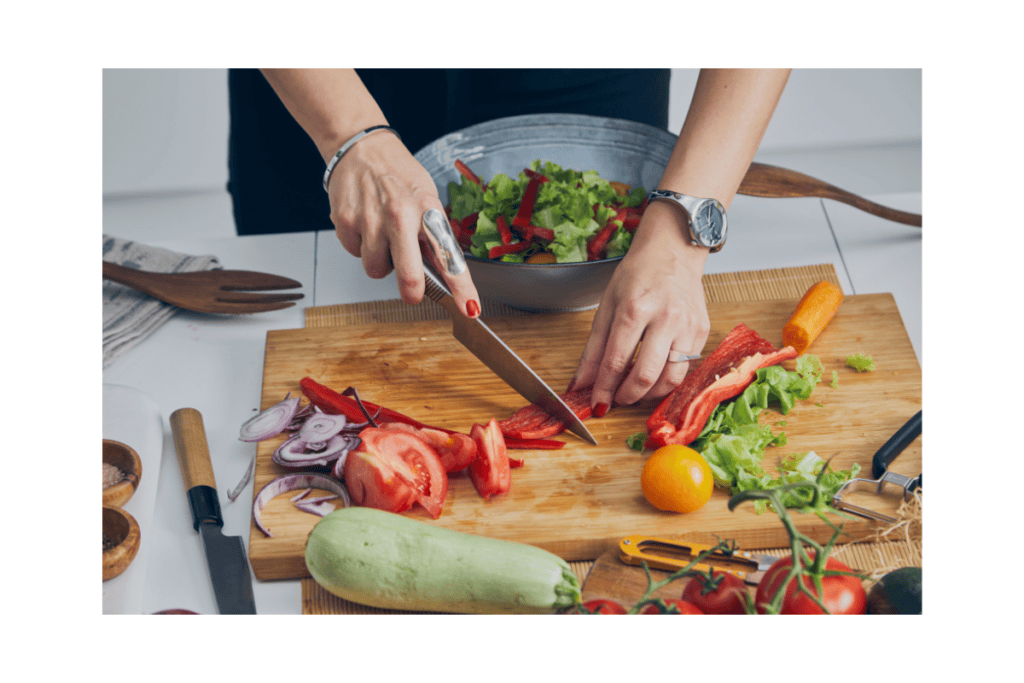
Questions People Ask Us All The Time
What three knives should every home cook own?
Every home cook should have a chef’s knife for everyday use, a paring knife for detail work, and a serrated knife for bread and tomatoes.
These three will handle almost everything you’ll ever need to do in the kitchen!
How often should I hone and sharpen my knives?
Hone your knives weekly (or each time you use them if you’re feeling fancy) and sharpen them every few weeks to keep them performing their best.
Regular maintenance makes a massive difference in how your knives work for you!
What’s the right way to hold a chef’s knife?
To hold a chef’s knife properly, grip the heel with your thumb and index finger while wrapping your other fingers around the handle.
This pinch grip gives you way better control and stability while you chop.
Why does it matter if my cuts are uniform?
Uniform cuts are a big deal because they ensure even cooking – no more half-burned, half-raw veggies.
When you chop your ingredients to the same size, you’re setting yourself up for a way better meal!
What’s chiffonade good for?
The chiffonade technique is perfect for slicing leafy greens into thin strips, which adds a beautiful touch to salads and finished dishes.
It’s an easy way to make your cooking look professional with minimal effort!
